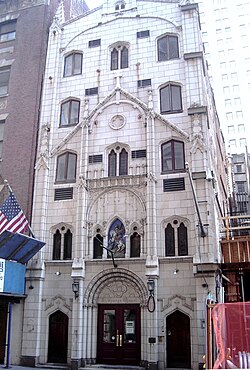This is an old revision of this page, as edited by Beyond My Ken (talk | contribs) at 22:27, 31 March 2012 (removed Category:Landmarks in New York City using HotCat). The present address (URL) is a permanent link to this revision, which may differ significantly from the current revision.
Revision as of 22:27, 31 March 2012 by Beyond My Ken (talk | contribs) (removed Category:Landmarks in New York City using HotCat)(diff) ← Previous revision | Latest revision (diff) | Newer revision → (diff) Historic site in Manhattan, New York City| St. George's Syrian Catholic Church | |
|---|---|
 (2012) (2012) | |
| Location | 103 Washington Street Manhattan, New York City |
| Built | c.1812, 1869, 1929 |
| Architect | Harvey F. Cassab |
| Architectural style(s) | Neo-Gothic |
| Governing body | private |
| New York City Landmark | |
 | |
St. George's Syrian Catholic Church is a former church located at 103 Washington Street between Rector Street and Carlisle Street in the Financial District of Manhattan, New York City. The church is the last physical reminder of the Syrian- and Lebanese-American community that once lived in Little Syria.
History
Originally three stories tall with a peaked roof, the structure was built c.1812, and by 1850 was being used as a boardinghouse for immigrants; an additional two stories were added on in 1869. In 1925, the building was purchased by George E. Bardwil, a textiles importer, for the use of the Syrian Catholic Church, organized in 1889 to serve the Syrian- and Lebanese-American community in the Little Syria neighborhood, also known as the Syrian Quarter. Four years later, Harvey F. Cassab, a Lebanese-American draftsman, was hired to create a new facade for the building. His neo-Gothic design in white terra cotta with a polychrome relief of St. George and the Dragon remains intact.
After World War II, the Syrian and Lebanese population in the area declined, in part because of the construction of the entrance ramps for the Brooklyn Battery Tunnel; the Eastern Mediterranean community later moved to Atlantic Avenue in Brooklyn, New York. The church briefly became a Roman Rite church, and then became disused as a church. In 1982 the building was bought by Moran Inc. and was turned into an Irish pub. The pub has now closed, however the building is still owned and maintained by Moran Inc.
The New York City Landmarks Preservation Commission designated the building a New York City landmark on July 14, 2009.
See also
References
- Notes
- ^ Caratzas, Michael D. "{Former} St. George's Syrian Church Designation Report" New York City Landmarks Preservation Commission (July 14, 2009)
External links
 Media related to St. George's Syrian Catholic Church at Wikimedia Commons
Media related to St. George's Syrian Catholic Church at Wikimedia Commons